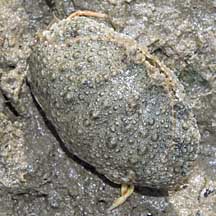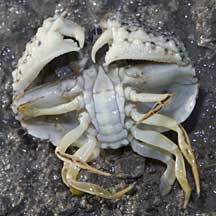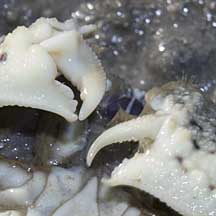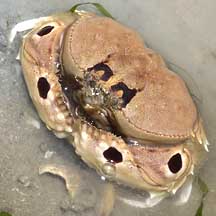 |
|
| crabs text index | photo index |
| Phylum Arthropoda > Subphylum Crustacea > Class Malacostraca > Order Decapoda > Brachyurans |
| Box
crabs Family Calappidae updated Dec 2019 Where seen? Box crabs are sometimes seen on some of our shores. Features: Body width 8-10cm. The crab does look rather box-like with a semi-circular body and wing-like extensions on the sides and back that cover part of the walking legs. It holds its pincers in front of its body to form a boxy shape. So it is sometimes also called the Shame-face crab as it appears to be covering its face in shame. What does it eat? The pincers of box crabs are specialised for cracking open snail shells. The snail is gripped in the left pincer which has pointed claws. With the right pincer, which is stronger, the crab cuts pieces of the shell from the shell opening. Once the gap is big enough, the crab can enjoy its snail meal. Status and threats: Our box crabs are listed as 'Vulnerable' on the Red List of threatened animals of Singapore. Like other creatures of the intertidal zone, they are affected by human activities such as reclamation and pollution. Trampling by careless visitors also have an impact on local populations. |
 Pulau Hantu, Apr 10 |
 Underside |
 Two different kinds of pincers. |
| Some Box crabs on Singapore shores |
 Reef box crab |
 Spotted box crab |
| Family
Calappidae recorded for Singapore from Wee Y.C. and Peter K. L. Ng. 1994. A First Look at Biodiversity in Singapore in red are those listed among the threatened animals of Singapore from Davison, G.W. H. and P. K. L. Ng and Ho Hua Chew, 2008. The Singapore Red Data Book: Threatened plants and animals of Singapore.
|
|
References
|